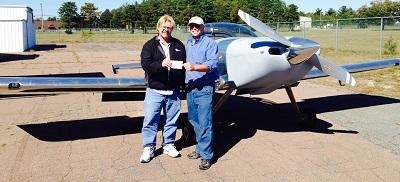First Known Issuance Of Operating Limitations Including The Additional Pilot Program Are Issued
The recently established Additional Pilot Program (APP) allows an additional crew member to be carried during phase 1 flight testing of an amateur built experimental aircraft. However, the program is complex, and EAA provided us with some of the following information.

The first known issuance of operating limitations that includes provisions of the FAA’s new Additional Pilot Program took place on October 5, for a Van’s RV-7 built by a Plymouth, MA builder. Designated Airworthiness Representative (DAR) Jon Ross inspected John Sannizzaro’s airplane and included the APP in the operating limitations.
That allows Sannizzaro the option to have a second pilot on board during Phase 1 flight testing. In addition to publishing the new program in AC 90-116 at the end of September, the FAA has also released a deviation memo to Order 8130.2G which allows inspectors and DARs to issue operating limitations to homebuilt aircraft that permit the use of the new program.
It’s important to remember that the operating limitations issued to an experimental aircraft defines and approves operation of the aircraft by the pilot. These limitations go far beyond the limitations that you would find in a type certificated aircraft. It’s important that builders, or owners of previously built experimental aircraft, review the operating limitations to see how they apply to the airplane and the pilot.
The Additional Pilot Program is really split into two parts; the qualified pilot (QP) and the observer pilot (OP). The QP is a pilot who meets certain experience criteria and is permitted to accompany the builder pilot on any flight of the aircraft during Phase 1 flight testing, including the first flight.
Once both the builder pilot and the aircraft have completed a basic set of tasks to achieve the most critical flight test and familiarization goals, an OP (this is any pilot who is rated in category and class and is current to fly the aircraft) may fly with the builder pilot as long as there is an agreed upon purpose for the OP’s presence. Examples of such a purpose might be spotting traffic during tests, troubleshooting instrumentation, etc.
The program is administered through FAA Advisory Circular AC 90-116, and enabled by language in the aircraft’s operating limitations. The APP may be used on any flight and is completely optional. Some builders may elect to fly with a QP on the first flight and never use the program again. Some may use one QP on the first flight and another QP on other flights. Others may skip using a QP and fly with an OP on several flights later in Phase 1 testing. The choice is entirely left up to the builder.
The initial release of this program is limited to aircraft “built from a kit” that is listed in the FAA’s Revised Listing of Amateur-Built Aircraft Kits. The aircraft must have an engine installation “recommended, supported, or provided by the kit manufacturer.”
Plansbuilt aircraft were not included in the first run of this program. This includes a plansbuilt version of an airplane kit. However, the FAA has shown a genuine willingness to expand the APP to more types of E-AB aircraft, including plansbuilt. This action may occur after the program has matured.
The qualification matrices for the QP appear complicated, but there are many ways to get the experience needed to add safety to the first few flights of an aircraft. The matrices are designed to allow pilots of diverse but equally relevant backgrounds to qualify. Another point to remember is that a candidate QP may qualify in the builder’s airplane. For example, if a pilot needs Phase 1 experience and time in type to earn enough points to qualify as a QP, he or she may fly the first flight of the builder’s aircraft solo, fulfill the experience items, and be qualified as a QP for the remainder of the flight-test program.
Many other details about the Additional Pilot Program can be found on EAA’s website.
(Photo of DAR Jon Ross, left, presenting the airworthiness certificate to John Sannizzaro for his newly completed RV-7; provided by EAA courtesy of Jon Ross)
 ANN's Daily Aero-Term (04.26.24): DETRESFA (Distress Phrase)
ANN's Daily Aero-Term (04.26.24): DETRESFA (Distress Phrase) ANN's Daily Aero-Linx (04.26.24)
ANN's Daily Aero-Linx (04.26.24) Airborne 04.22.24: Rotor X Worsens, Airport Fees 4 FNB?, USMC Drone Pilot
Airborne 04.22.24: Rotor X Worsens, Airport Fees 4 FNB?, USMC Drone Pilot Airborne 04.24.24: INTEGRAL E, Elixir USA, M700 RVSM
Airborne 04.24.24: INTEGRAL E, Elixir USA, M700 RVSM Airborne-NextGen 04.23.24: UAVOS UVH 170, magni650 Engine, World eVTOL Directory
Airborne-NextGen 04.23.24: UAVOS UVH 170, magni650 Engine, World eVTOL Directory



